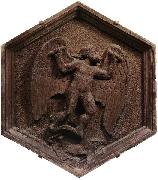|
|
|
|
|
GIOTTO di Bondone
|
|
Daedalus_after
|
|
|
|
|
|
|
|

|
|
Click to Enlarge
|
| GIOTTO_di_Bondone
|
Daedalus after
new21/GIOTTO di Bondone-762429.jpg
|
|
|
|
|
|
| 1334 Marble Museo dell'Opera del Duomo, Florence In Greek mythology Daedalus stands as a creative worker at the beginning of all art: Daedalus, the inventor of the labyrinth and of flying, is supposed to have been the first successfully to create a sculpture with arms akimbo and parted legs. Since he is thus supposed to have given life to figures for the first time, he is considered as the very first artist. The design of this relief, though not its execution, derives from Giotto. It shows Daedalus in a striding posture on top of a cupola that acts as a launching pad. All of his energy seems directed towards lifting his heavy, feather-covered body into the air. This concentration of energy corresponds to the energy of Giotto's painted figures. With one exception, this is the only portrayal of Daedalus to exist between the era of ancient Rome and the age of the Renaissance. Artist: GIOTTO di Bondone Painting Title: Daedalus , 1301-1350 Painting Style: Italian , , religious |
|
|
Italian Early Renaissance Painter, 1267-1337
Italian painter and designer. In his own time and place he had an unrivalled reputation as the best painter and as an innovator, superior to all his predecessors, and he became the first post-Classical artist whose fame extended beyond his lifetime and native city. This was partly the consequence of the rich literary culture of two of the cities where he worked, Padua and Florence. Writing on art in Florence was pioneered by gifted authors and, although not quite art criticism, it involved the comparison of local artists in terms of quality. The most famous single appreciation is found in Dante's verses (Purgatory x) of 1315 or earlier. Exemplifying the transience of fame, first with poets and manuscript illuminators, Dante then remarked that the fame of Cimabue, who had supposed himself to be the leader in painting, had now been displaced by Giotto. Ironically, this text was one factor that forestalled the similar eclipse of Giotto's fame, which was clearly implied by the poet.
|
|
|
|
|
|
|